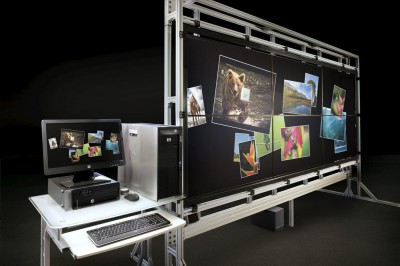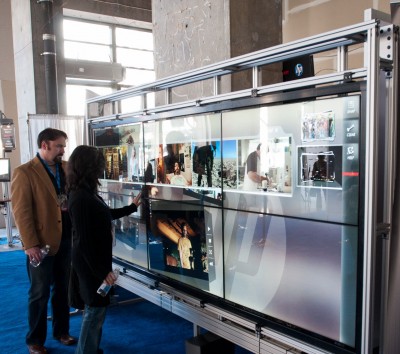
A variety of innovations in technology have broken down past barriers, allowing easier adoption of video walls.
Another reason is the growing market demand for digital signage in configurations where standard, stand-alone LCDs would not have sufficient visual impact.
“Immersive visuals demand attention,” says Bob Rosenberry, HP’s global product manager for digital signage and self-service systems. “A multi-screen layout provides this larger canvas for larger spaces, from lobbies to concourses to stadiums. You can pack in more information for menu boards, flight information screens and command-and-control centres. And you can display life-size images, such as a ‘virtual mannequin’ in a fashion store.”
These are just a few examples of how video walls have also become more versatile, whether they are specified for branding, ambience or other purposes.
Setup considerations
It is important to keep the intended purpose in mind when setting up a video wall in the first place.
“The puzzle is getting easier to put together,” says Rosenberry. “Any high-quality video source will technically work. The questions are: do you have enough resolution? What is the viewing distance? Do you need discrete control of each screen or is your content going to be just one constant feed that expands across the displays?”
For the latter option, he recommends a minimum resolution of 1,920 x 1,080 pixels.
Complex content may combine video, text, data, Flash content and other elements. Native resolution for pixel-to-pixel clarity is beneficial for text-heavy content, allowing it to be read easily. Digital signage software can be used to render content up to the desired size.
Colour calibration is an ongoing concern when ensuring consistency across the panels. Many video walls are operated 24-7. As a system ages, the need for colour calibration will become clearer, though most video walls will last two years before the time comes to change out any of their panels.
According to Rosenberry, there are three main connectivity options when setting up a video wall:
- Daisy-chaining—LCDs with integrated video-in and -out ports are connected in a matrix configuration. This is a low-cost option that works with almost any personal computer (PC) player and reduces the need for additional audiovisual (AV) equipment. A built-in scaler is used to expand content across the LCD array.
- PC players with multi-head graphics cards—This equipment supports native resolution with no need for scaling. PC-based software is used to manage the display matrix. The system can easily be expanded as needed.
- Hardware video-wall processors—This equipment enables multiple inputs for display arrays. As such, it has become a popular option for command-and-control centres.
Interactivity
Another trend is the enhancement of video walls with touch-based interactivity. Here too, there are different technology options to consider.
“We see applications being customized to enable an immersive experience,” says Bowden. “You need to consider the user experience, the construction and the cost.”

Many video walls are being enhanced with touch-based interactivity. This can be facilitated through the addition of a special overlay.
The following are some common touch-screen technologies:
- Optical—Cameras or sensors are used at the top and/or sides of the video wall structure to detect where the user touches the screen. This option tends to be less accurate than others and cannot support multi-touch applications unless four or more cameras are installed. The wall may also need a custom frame.
- Infrared—This option usually involves a frame around the video wall. Infrared (IR) sensors can be more accurate than optical sensors, though they should only be used indoors, as ambient light rays could interfere with their ability to detect touches.
- Projected capacitive—This multi-touch-friendly technology is common to today’s smart phones and tablet computers, but becomes much more expensive to implement at a larger size than IR or optical touch screens. It is not economical for LCDs beyond 0.5 m (20 in.).
Bowden recommends starting with non-touch-enabled LCDs and then adding a touch-sensitive overlay, as well as specifying ultra-narrow bezels to minimize interference with the user experience.
Further interactivity becomes possible with gesture recognition technologies. Touch systems may recognize on-screen gestures, but extra hardware is needed to support in-air gestures, including three-dimensional (3-D) camera sensors. With a natural user interface (NUI), video walls can enable augmented reality (AR) applications, among others.
“Content strategies are becoming as immersive as possible, as a video wall provides a very different user experience than a smaller screen,” says Bowden. “It’s a question of how to extend user interactions.”
With files from Christie and HP. For more information, visit www.christiedigital.com and www.hp.ca.






